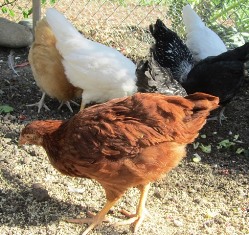You Can’t Hurry a Chicken into Laying an Egg
I brought home my little flock of baby chicks on March 7. Yesterday marked 16 weeks or four months. That’s important because that’s when the feed store told me I could start expecting eggs from my White Leghorns. Not with mine. They are taking their own sweet time.
The Rhode Island Red can take between 20 and 26 weeks–or so I’ve been told–to start laying. Mine just wants to forage in the yard, follow me around, get in my face, and eat any extra blueberries that I didn’t consume with my morning yogurt and honey. I had a talk with her yesterday about how I’m expecting some eggs in return for all those blueberries.
My flock also includes a Buff Orpington, a Black Sex Link, an Ameraucana, and two Silver Laced Wyandottes, the latter is an old heritage breed can take up to 32 weeks to begin laying. So maybe around Halloween, I’ll find their first offerings.
In anticipation of the big egg-laying event, I’ve switched the chicken food to a crumble for laying hens. Tomorrow I will buy some oyster shell calcium for strong egg shells. I’ve also tucked smooth, wooden eggs into their nesting boxes with some soft straw, hoping to encourage the girls to get with it.
Their voices have now changed from the peep, peep, to cluck, cluck. But I’ve yet to hear that loud cackle that tells me an egg has been laid. Sometimes I’ll see one of some serious squatting and get excited. Okay, this is it. But so far, it isn’t.
So the watch goes on. You can’t hurry a chicken who isn’t ready to produce eggs. So in the meantime, I’ll be eating a lot more yogurt and berries for breakfast.
 Facebook
Facebook Goodreads
Goodreads LinkedIn
LinkedIn Meera Lester
Meera Lester Twitter
Twitter






